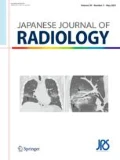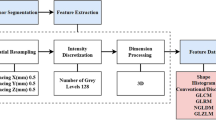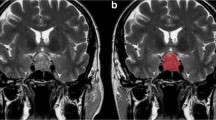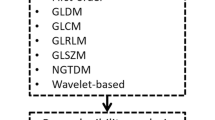Abstract
Purpose
To investigate differences between pituitary adenoma and craniopharyngioma on magnetic resonance imaging (MRI) with image features and three-dimensional texture features.
Materials and methods
A total of 126 patients diagnosed with pituitary adenoma (N = 63) or craniopharyngioma (N = 63) were enrolled. Qualitative magnetic resonance (MR) image features and texture features of tumors were extracted from preoperative MRI and evaluated using chi-square test or Mann–Whitney U test. Binary logistic regression analyses were performed to assess their abilities as independent diagnostic predictors, and ROC analyses were conducted to evaluate the diagnostic value of significant features. Mann–Whitney U test and ROC analyses were performed to explore the relationship between MR image features and texture features.
Results
Five MR image features were suggested to be significantly different between pituitary adenoma and craniopharyngioma. Three texture features from contrast-enhanced T1WI (HISTO-Skewness, GLCM-Contrast and GLCM-Energy), two texture features from T2WI (HISTO-Skewness and GLCM-Contrast) showed significant differences between two types of tumors. Logistic regression analyses suggested GLCM-Energy from contrast-enhanced T1WI, HISTO-Skewness and GLCM-Contrast from T2WI could be taken as independent predictors. Moreover, HISTO-Skewness and GLCM-Contrast from T2WI were found to be significantly related to cystic change.
Conclusion
MR image features and texture features were associated with each other, and both types of features represented feasible diagnostic value in discrimination between pituitary adenoma and craniopharyngioma.




Similar content being viewed by others
Data availability
The data used to support the findings of this study are available from the corresponding author upon request.
References
Jagannathan J, Kanter AS, Sheehan JP, Jane JA Jr. Laws ER, Jr Benign brain tumors sellar/parasellar tumors. Neurol Clin. 2007;25(4):1231–49. https://doi.org/10.1016/j.ncl.2007.07.003.
Laws ER Jr, Thapar K. Pituitary surgery. Endocrinol Metab Clin North Am. 1999;28(1):119–31.
Müller HL, Merchant TE, Warmuth-Metz M, Martinez-Barbera J-P, Puget S. Craniopharyngioma. Nat Rev Dis Primers. 2019;5(1):75. https://doi.org/10.1038/s41572-019-0125-9.
Davis JR, Farrell WE, Clayton RN. Pituitary tumours. Reproduction. 2001;121(3):363–71.
Muller HL. Craniopharyngioma. Endocr Rev. 2014;35(3):513–43. https://doi.org/10.1210/er.2013-1115.
Molitch ME. Diagnosis and treatment of pituitary adenomas a review. JAMA. 2017;317(5):516–24. https://doi.org/10.1001/jama.2016.19699.
Raman SP, Chen Y, Schroeder JL, Huang P, Fishman EK. CT texture analysis of renal masses: pilot study using random forest classification for prediction of pathology. Acad Radiol. 2014;21(12):1587–96. https://doi.org/10.1016/j.acra.2014.07.023.
Eliat PA, Olivie D, Saikali S, Carsin B, Saint-Jalmes H, de Certaines JD. Can dynamic contrast-enhanced magnetic resonance imaging combined with texture analysis differentiate malignant glioneuronal tumors from other glioblastoma. Neurol Res Int. 2012;2012:195176. https://doi.org/10.1155/2012/195176.
Lopes R, Ayache A, Makni N, Puech P, Villers A, Mordon S, et al. Prostate cancer characterization on MR images using fractal features. Med Phys. 2011;38(1):83–95. https://doi.org/10.1118/1.3521470.
Holli K, Laaperi AL, Harrison L, Luukkaala T, Toivonen T, Ryymin P, et al. Characterization of breast cancer types by texture analysis of magnetic resonance images. Acad Radiol. 2010;17(2):135–41. https://doi.org/10.1016/j.acra.2009.08.012.
Alis D, Bagcilar O, Senli YD, Yergin M, Isler C, Kocer N, et al. Machine learning-based quantitative texture analysis of conventional MRI combined with ADC maps for assessment of IDH1 mutation in high-grade gliomas. Jpn J Radiol. 2020;38(2):135–43. https://doi.org/10.1007/s11604-019-00902-7.
Briet C, Salenave S, Bonneville JF, Laws ER, Chanson P. Pituitary apoplexy. Endocr Rev. 2015;36(6):622–45. https://doi.org/10.1210/er.2015-1042.
Nioche C, Orlhac F, Boughdad S, Reuzé S, Goya-Outi J, Robert C, et al. Lifex a freeware for radiomic feature calculation in multimodality imaging to accelerate advances in the characterization of tumor heterogeneity. Cancer Res. 2018;78(16):4786–9. https://doi.org/10.1158/0008-5472.can-18-0125.
Lakhman Y, Veeraraghavan H, Chaim J, Feier D, Goldman DA, Moskowitz CS, et al. Differentiation of uterine leiomyosarcoma from atypical leiomyoma diagnostic accuracy of qualitative MR imaging features and feasibility of texture analysis. Eur Radiol. 2017;27(7):2903–15. https://doi.org/10.1007/s00330-016-4623-9.
Fujima N, Homma A, Harada T, Shimizu Y, Tha KK, Kano S, et al. The utility of MRI histogram and texture analysis for the prediction of histological diagnosis in head and neck malignancies. Cancer Imaging. 2019;1(1):5. https://doi.org/10.1186/s40644-019-0193-9.
Rodriguez Gutierrez D, Awwad A, Meijer L, Manita M, Jaspan T, Dineen RA, et al. Metrics and textural features of MRI diffusion to improve classification of pediatric posterior fossa tumors. AJNR Am J Neuroradiol. 2014;35(5):1009–155. https://doi.org/10.3174/ajnr.A3784.
Yildiz AE, Oguz KK, Fitoz S. Suprasellar masses in children characteristic MR imaging features. J Neuroradiol. 2016;43(4):246–59. https://doi.org/10.1016/j.neurad.2016.03.009.
Muller HL, Gebhardt U, Faldum A, Warmuth-Metz M, Pietsch T, Pohl F, et al. Xanthogranuloma, Rathke's cyst, and childhood craniopharyngioma results of prospective multinational studies of children and adolescents with rare sellar malformations. J Clin Endocrinol Metab. 2012;97(11):3935–43. https://doi.org/10.1210/jc.2012-2069.
Guaraldi F, Prencipe N, di Giacomo V, Scanarini M, Gasco V, Gardiman MP, et al. Association of craniopharyngioma and pituitary adenoma. Endocrine. 2013;44(1):59–655. https://doi.org/10.1007/s12020-013-9892-3.
Choi SH, Kwon BJ, Na DG, Kim JH, Han MH, Chang KH. Pituitary adenoma craniopharyngioma and Rathke cleft cyst involving both intrasellar and suprasellar regions differentiation using MRI. Clin Radiol. 2007;62(5):453–62.
Burrell RA, McGranahan N, Bartek J, Swanton C. The causes and consequences of genetic heterogeneity in cancer evolution. Nature. 2013;501(7467):338–45. https://doi.org/10.1038/nature12625.
Just N. Improving tumour heterogeneity MRI assessment with histograms. Br J Cancer. 2014;111(12):2205–13. https://doi.org/10.1038/bjc.2014.512.
Gerlinger M, Rowan AJ, Horswell S, Math M, Larkin J, Endesfelder D, et al. Intratumor heterogeneity and branched evolution revealed by multiregion sequencing. New Eng J Med. 2012;366(10):883–92. https://doi.org/10.1056/NEJMoa1113205.
Nardone V, Tini P, Nioche C, Mazzei MA, Carfagno T, Battaglia G, et al. Texture analysis as a predictor of radiation-induced xerostomia in head and neck patients undergoing IMRT. Radiol Med (Torino). 2018;123(6):415–23. https://doi.org/10.1007/s11547-017-0850-7.
Areeckal AS, Jayasheelan N, Kamath J, Zawadynski S, Kocher M, David SS. Early diagnosis of osteoporosis using radiogrammetry and texture analysis from hand and wrist radiographs in Indian population. Osteoporosis International A Journal Established As Result Of Cooperation Between The European Foundation For Osteoporosis And The National Osteoporosis Foundation Of The USA. 2018;29(3):665–73. https://doi.org/10.1007/s00198-017-4328-1.
Li Z, Yu L, Wang X, Yu H, Gao Y, Ren Y, et al. Diagnostic performance of mammographic texture analysis in the differential diagnosis of benign and malignant breast tumors. Clin breast cancer. 2018;18(4):e621–e627627. https://doi.org/10.1016/j.clbc.2017.11.004.
Lisson CS, Lisson CG, Flosdorf K, Mayer-Steinacker R, Schultheiss M, von Baer A, et al. Diagnostic value of MRI-based 3D texture analysis for tissue characterisation and discrimination of low-grade chondrosarcoma from enchondroma a pilot study. Eur Radiol. 2018;28(2):468–77. https://doi.org/10.1007/s00330-017-5014-6.
Verma RK, Wiest R, Locher C, Heldner MR, Schucht P, Raabe A, et al. Differentiating enhancing multiple sclerosis lesions glioblastoma and lymphoma with dynamic texture parameters analysis (DTPA) a feasibility study. Med Phys. 2017;44(8):4000–8. https://doi.org/10.1002/mp.12356.
Funding
This work was supported by 1.3.5 project for disciplines of excellence, West China Hospital, Sichuan University (ZYJC18007); Key research and development project of science and technology department of Sichuan Province (2019YFS0392).
Author information
Authors and Affiliations
Contributions
YZ contributed to the study conception, image evaluation, feature extraction, and drafted the manuscript. CC contributed to the image evaluation, feature extraction and manuscript revision. ZT contributed to the data collection and statistical analysis. JX contributed to the study conception and manuscript revision. All authors read and approved the final manuscript. YZ and CC contributed equally to this work and should be considered as co-first authors.
Corresponding author
Ethics declarations
Conflict of interest
The authors declare that they have no conflict of interest.
Ethical approval
All procedures performed in studies involving human participants were in accordance with the ethical standards of the institutional and/or national research committee and with the 1964 Helsinki declaration and its later amendments or comparable ethical standards.
Informed consent
Informed consent was obtained from all individual participants included in the study.
Additional information
Publisher's Note
Springer Nature remains neutral with regard to jurisdictional claims in published maps and institutional affiliations.
Electronic supplementary material
Below is the link to the electronic supplementary material.
About this article
Cite this article
Zhang, Y., Chen, C., Tian, Z. et al. Discrimination between pituitary adenoma and craniopharyngioma using MRI-based image features and texture features. Jpn J Radiol 38, 1125–1134 (2020). https://doi.org/10.1007/s11604-020-01021-4
Received:
Accepted:
Published:
Issue Date:
DOI: https://doi.org/10.1007/s11604-020-01021-4




